The rise of digital technology is disrupting the traditional contact center. The exponential growth in connected devices, as well as social media and apps, is fundamentally changing how people engage with brands. This creates a stark challenge that your business is probably already grappling with: as more customers move online, so must customer service. Faced with growing expectations for personalized, real-time engagement, more organizations are striving to reach customers over the internet. Examples include online chat, social media, and mobile messaging tools such as Facebook Messenger and WhatsApp.
The transformation of customer support into online customer service is about more than creating multichannel options for customers. Today, the world’s most competitive brands invest in consistent omni-channel experiences that bring together their various touchpoints. Simultaneously, at the back end of their operations, businesses are using cloud services, data analytics, and artificial intelligence (AI) to develop a sophisticated understanding of their market. And some companies that specialize in connected products are even branching out into new revenue streams such as predictive maintenance and service.
At Salesforce, we help guide businesses as they navigate these difficult issues. We know that online customer service is evolving and that technologies such as AI can serve customers even better.
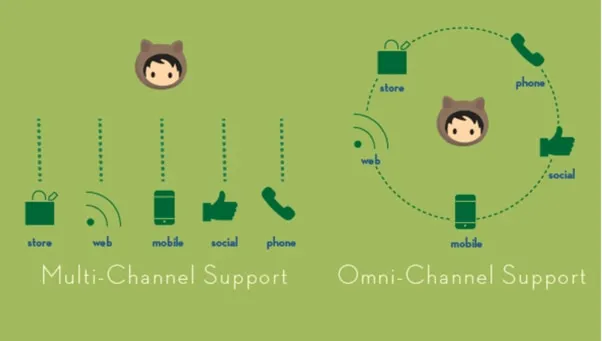
Why is customer service changing?
Technology is revolutionizing our lives in ways that few would have foreseen even a decade ago. People are hooked on devices wherever they go — public transport, at work, and even in bed — and using them to do everything from conduct banking transactions to book flights. AI is beginning to permeate everyday life through voice-activated assistants such as Alexa and Siri. These assistants offer personalized product recommendations by self-learning from past customer preferences and purchase histories.
The customer has nearly complete control. It’s the customer that decides how and when to make a service request, or what channel to use for complaints. For example, businesses can face huge embarrassment when an unhappy shopper lets fly on their social media page. Customers are also keenly aware of the high level of service that new technology enables and they have limited patience for brands that can’t keep up with evolving standards.
How businesses can respond to online customer service expectations
Today, companies have a choice. They can transform how they engage with customers by developing new means of communication. Alternatively, they risk falling behind and surrendering their edge in the market.
The priority should always be to meet the customer where they want to be, rather than forcing them onto a different channel. It is no longer sufficient for a business to say, “Here’s our phone number, so call us if you have an issue” — particularly when a competitor is offering more comprehensive support mechanisms. This potentially forces a bad experience on the customer before they even have their issue resolved: They never want to call and be kept on hold.
Businesses need to realize that not every online customer support case requires resolution through human interaction. Simple tasks can be completed more efficiently by inviting customers to help themselves. This might involve accessing content or crowdsourcing answers from a curated community. Alternatively, the business may initiate an automated online chatbot. Powered by AI capabilities such as natural language processing, chatbots can answer preliminary questions that don’t need to go to busy customer service agents. More complex issues can then be referred to in-person support teams as required.
Online customer service represents a potential win-win. Businesses that offer a range of service types, from self-service to full service, give customers flexibility. However, they also save time and money by directing customers to the most appropriate channel for their request.
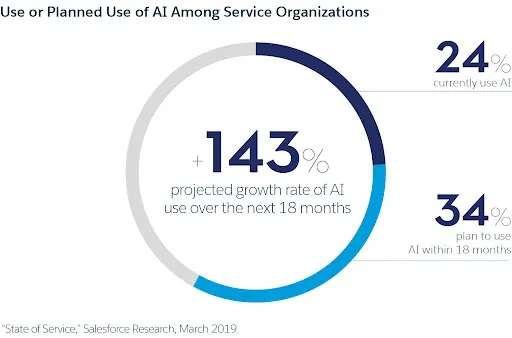
How are millennials and Gen Z impacting online customer service standards?
The popularity of digital channels is being driven by millennials (those born between 1980 and 1995), and particularly Generation Z (those born from 1996 to 2015) who are growing up in a world of ubiquitous technology. At the same time, a massive generational shift is occurring in most countries as aging baby boomers (those born before 1960) move into retirement. Raised in an era when the phone was the fastest means of communication, members of this generation often still prefer to use the phone to resolve service issues. It’s important for contact centers to have a mix of service channels available so they can offer a wide range of customer support options for their audience.
What are the new digital customer service channels?
The average customer now uses 10 different channels to communicate with companies. While phone and email have near-universal adoption, customer service is on the cusp of a digital revolution. Salesforce’s “State of Service” report, based on insights from more than 3,500 customer service agents and decision-makers worldwide, indicates that the popularity of certain channels is soaring worldwide.
Some examples include:
1. Self-service portals and communities: As self-service becomes a major part of organizations’ customer service strategies, portals help customers find answers fast and on their own terms — whether this involves basic account information, enriched content, or pooled tips from a wider community of customers. Processes started in the portal can be easily transferred to an agent. While nearly two-thirds of service organizations use portals today, 84% are expected to by 2020.
2. Live chat: According to Salesforce’s research, 52% of organizations currently use online chat or live support and another 23% plan to incorporate it by 2020. Agents can launch an on-screen message based on how the customer is engaging with the organization’s website or app. Where live chats are cross-matched with the customer’s profile, customers can be routed to the most appropriate agent or receive multilingual support. Supervisors also have the ability to monitor queues and balance agents’ workloads.
3. Video chat and multichannel interaction: Customers can receive an even more comprehensive multichannel experience through embedded services while browsing a business’s website. This could involve clicking on relevant articles and information. It might mean accessing live audio or two-way video chat on their mobile device, allowing them to physically demonstrate the exact nature of their support need to agents. Video support is currently used by 33% of service organizations; however, adoption is expected to nearly double by 2020. This makes it one of the fastest growing channels, second only to voice-activated personal assistants.
4. Social networks: Currently 72% of service organizations are using social monitoring tools to identify and action posts by customers on channels like Facebook, Twitter, Instagram, and YouTube. Sophisticated language detection techniques, including the use of keywords and classifiers, allow online sentiment to be accurately tracked. Where social monitoring tools are integrated with the organization’s customer relationship management system, agents enjoy a comprehensive 360-degree view of the customer before responding.
5. Automated chatbots: Simulating voice or text-based conversations with humans is perhaps the most exciting example of AI in customer service. It is particularly suited to gathering initial case information from the customer and enabling self-service, freeing agents to work on more strategic tasks or complex queries. The technology can be customized and used on mobile devices, web browsers, and messaging platforms. Teams are still experimenting with AI chatbots. About 23% of service organizations use them today and 53% expect to do so by 2020 — a 136% growth rate that foreshadows a big role in the near future.
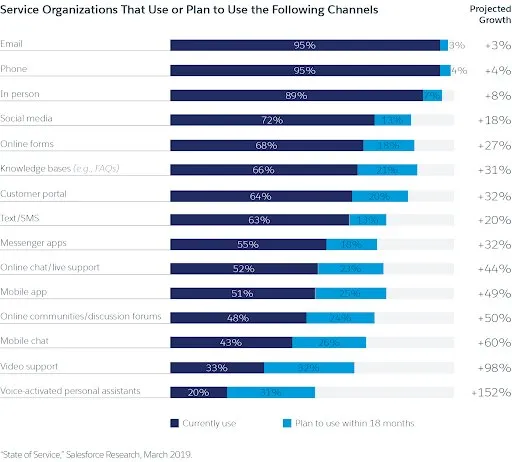
How can online customer support be improved?
Despite the progress being made by service teams, today’s customers are, on average, 16 percentage points more likely to use a given channel to communicate with companies than a company is to offer service on that channel. That means there is a huge gap between what people want in terms of online customer support and what organizations are delivering. The gap is even wider when it comes to emerging service channels such as voice-activated personal assistants and mobile apps.
There are some simple steps that companies can take to catch up. We recommend you start with the following seven tips before going on to consider several important strategic questions.
- Consider your customers’ support needs: If most of your customers are engaging via your website, for example, make sure they can find the answers right there.
- Provide self-service options: Some customers don’t want to ask for help to every little question.
- Create content: By supplying e-books, webinars, and videos, you don’t need to create a separate reply for customers each time they contact you.
- Respect your customers’ time: The longer you make customers wait to hear from you, the more chance they’ll seek out your competitors.
- Convey empathy: Matching your virtual tone to the customer lets them know you’re on their side.
- Improve your product knowledge: Online customer support teams may not have customers physically in front of them but should still know products inside out.
- Empower your entire team: You can create a customer-centric culture by having everyone in the organization participate in customer support activities.
Adopt an omni-channel mindset
The customer journey is rarely linear or limited to a single department. As such, it is not enough for a company to merely offer a given communications channel. According to Salesforce’s research, 70% of customers expect consistent experiences across channels. This includes recognition of their previous interactions with different aspects of the business, from in-store assistants to online technical support. However, only 16% of customers say companies generally excel at this.
Providing a customer experience that feels the same, regardless of business unit, requires collaboration across the company. For example, a customer who makes an online purchase should be able to return it to the company’s nearest physical location. Or, if someone inputs into a web chat, the system should have access to previous interactions. Businesses should always remember that customers only see “one brand” and seek a connected service experience that’s as fast, easy, and personalized as face-to-face interactions.
Incorporate AI in your service strategy
Customer service agents assisted by AI can better understand customers’ preferences, behaviors, transactions, and sentiment. With this extra information, they can better influence customers’ choices, decisions, and the outcome of a call. While adoption of AI is nascent, it is set to soar as more teams turn to chatbots, text, and voice analytics, and other use cases. Our research projects that the use of AI by customer service teams will increase by 143% by 2020.
AI allows service agents to provide the human touch when needed while allowing smart tools to do most of the work. As we have noted, automated chatbots can resolve routine customer requests. They also accelerate case resolution by automatically predicting case fields, and prioritizing and routing cases to the right agents. Predictive intelligence can assess past data to help agents identify customers who are at risk of taking their business elsewhere and tempting them back with special offers.
When a customer wants to talk to an agent, the hand-off is easy. The interaction with the bot is transferred into the agent console so customers don’t have to repeat what they’ve typed before. This reduces the average handle time because the agent has all previous interaction history and can quickly resolve the issue with the proper information and context.
What if a customer wants to talk directly to an agent without interacting with a chatbot? AI can collect information about the customer and prioritize and classify cases to help agents quickly understand what the customer needs. With the administrative work done by AI, agents can focus on challenging customer support issues requiring their problem-solving skills. As a result, they gain a sense of accomplishment from building loyal relationships and directly making a difference.
Mobilize your business data
The first step for businesses wishing to incorporate AI is deciding which features to automate. For example, what questions do customers ask you that could easily be answered by a chatbot? How could forms be streamlined by pre-filling fields? In particular, organizations should consider what metrics they are looking to improve such as average handle time, first contact resolution, and customer satisfaction ratings. They can then begin to strategically decide how to use AI to transform contact center operations, positively impact customer and agent experiences, and improve the bottom line.
Fundamentally, for AI to deliver on the promise of better customer self-service and more efficient agent interactions, it needs to learn from business data. The foundation of AI is data. Since AI is only as good as the data it interacts with, we suggest looking for an “AI-inside” solution; one where the AI is built into the customer relationship management (CRM) platform where customer records and previous interaction histories are stored.
Of course, it is even better if the same AI solution is also integrated into applications used by sales, marketing, e-commerce, and other parts of the business. The more contextual information that exists about a customer across all departments, the better business results that AI can provide.
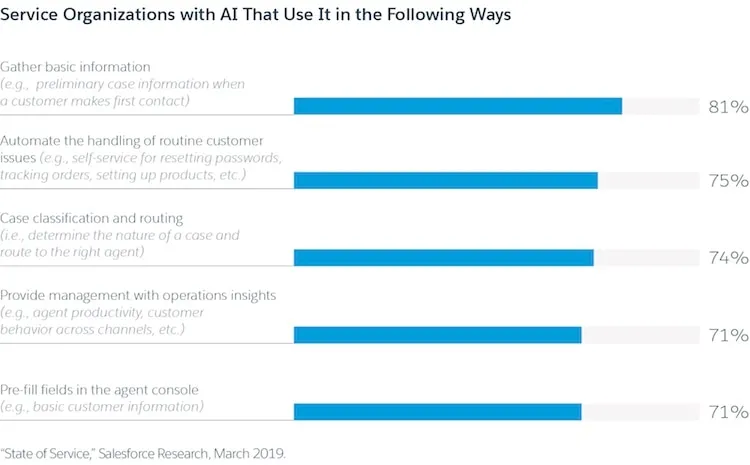
How can online customer service generate new revenue streams?
In the era of digital transformation, innovative companies realize that to stay competitive they must explore entirely new business and revenue models. The explosion in the number of connected devices — with the so-called Internet of Things (IoT) expected to comprise more than 20 billion objects by 2020 — offers one such opportunity.
A connected device — whether it is a household appliance, security camera, autonomous vehicle, or something else — can be monitored constantly. This places a new importance on customer service both pre- and post-purchase.
While most companies offer scheduled maintenance as part of an equipment service contract, practices are starting to evolve. Thanks to IoT, companies are accessing real-time performance data from connected devices to gain visibility into the current condition of the equipment. They are then using that information to deliver field service. Instead of performing regularly scheduled maintenance every three months, for example, people are prioritizing work according to data from sensors that indicate an asset’s health. Action is only being taken based on the probability of an outage or the necessity of an upgrade.
Training customer service agents for the future
The job of a customer service agent is not easy. In a typical contact center, agents are multitasking and communicating through a variety of channels. Customers can be upset about anything from payment disputes to delayed packages. Their impression of the company is directly related to their experience with the contact center and its agents. And since customer experience directly affects revenue, the pressure on agents is intense.
Today, it’s no longer sufficient for agents to focus on closing as many cases as possible in as little time when it comes to delivering outstanding customer support. Instead, they are required to build relationships and drive revenue. This involves a transition away from routine tasks such as resetting passwords, determining order statuses, and processing returns, and towards strategic tasks such as upselling customers using digital tools and capabilities.
Accordingly, it is only right that employers do more to upskill the customer service workforce. Nearly two-thirds of service decision-makers (63%) cite improving workforce skills as a high priority, and 77% are making significant investments in agent training.
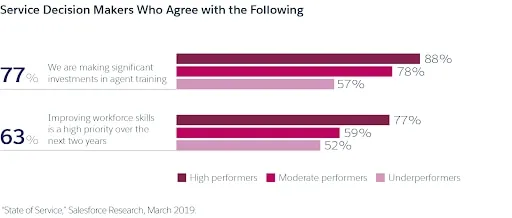
Ultimately, caring about the needs of the customer and exceeding their expectations is what great customer service is about. While there is much hype about AI replacing jobs, in customer service it’s a case of equipping people with the best possible technology to do their jobs even better.
For more information on online customer service and AI, check out the Salesforce “State of Service” research report.




























